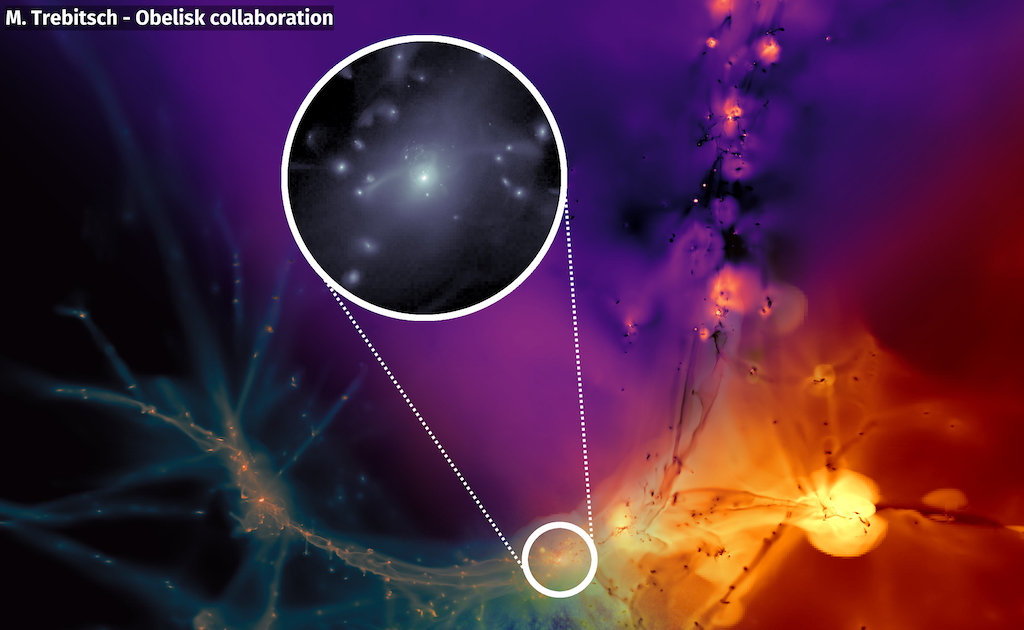SEGAL
The Secular Evolution of galaxies
| SEGAL aims to explore statistically the long-term evolution of self-gravitating systems using recent theoretical breakthroughs in Kinetic theory which offer unique physical insights into the competing dynamical processes at play, complementing N-body approaches. We will gauge the respective roles of nature vs. nurture in establishing the galaxies’ observed properties, using stochastic processes capturing both (internal and external) sources of fluctuations. We will determine characteristic timescales, and examine signatures of secular evolution. |
Context Gravity is the driving force in galaxies, from their far outskirts to their very inner core. SEGAL is a plan to statistically explore their long-term evolution using recent theoretical breakthroughs which explicitly account for their self-gravity and resonances. To this end, we co-developed extended kinetic theories, and pioneered their implementation to provide unique physical insights into the competing dynamical processes at play, complementing N-body approaches. This is a particularly timely topic: i) new instruments like Gaia and Gravity now provide a wealth of information on the dynamical state of our Galaxy, past and present; ii) we now have a robust cosmic paradigm for the formation of structures: on galactic and sub-galactic scales, galaxies’ long-term interaction with the environment can now be quantified in detail. As a result, we will be able to gauge the respective roles of nature vs. nurture in establishing the galaxies’ observed properties, using stochastic processes derived from our kinetic theories to capture both sources of fluctuations. We will determine characteristic timescales, and examine signatures of secular evolution in this unified (open box) computational framework on two galactic scales: from the cusp-core transformation of inner dark halos, over to the metallicity-velocity dispersion evolution in the galactic disc, its thickening via giant molecular clouds and clumps, all the way down to the resonant relaxation of the central cluster and its black hole.
SEGAL stands out because it tackles galactic evolution in a truly novel way compared to the state-of-the art: it adopts techniques from stochastic and finite element theory, and treats processes statistically, while capturing the astrophysical differences at each nested scale and their mutual interactions. Our unique framework can model various components of galaxies (nuclear clusters, galactic discs, inner dark halos), describable through the same approach, as gravity governs them all. It provides a great opportunity to go beyond today’s closed-box perspective and advance the field towards a detailed understanding of the cosmic fate of these inter-connected self-gravitating systems over half a Hubble time.
In the expanding universe, an overdense perturbation passing a critical threshold will collapse onto itself and, through violent relaxation and mergers, rapidly converge towards a stationary, phase-mixed and highly symmetric state. This perturbation will convert its cold gas into stars and, depending on how much entropy has been radiated away, produce either a spiral or an elliptical galaxy, with a partially frozen orbital structure. The galaxy is then essentially locked in a quasi-stationary state imposed by its mean gravitational field while the universe quietens. Yet such a self-gravitating relaxed system can still undergo a wide variety of dynamical processes, depending on its environment and on its internal structure and ‘temperature’– i.e. whether it is more pressure or centrifugally supported. Of particular interests are strongly responsive colder discs which, given time and/or stimuli, have the opportunity to significantly reshuffle their orbital structure towards more likely configurations through resonant interactions.
SEGAL aims to understand this long-term reshuffling called secular evolution and described by extended kinetic theory. Indeed, the recent culmination of a line of analytical work means we are now in a position to investigate statistically the dynamics of galaxies over cosmic time. In the seventies, the pioneering papers of Toomre’64, Goldreich+’65, Kalnajs’76, Tremaine+’84 derived the self-consistent linear-response theory for these self-gravitating systems on dynamical timescales. Thanks to the recent kinetic work of Weinberg’01, Pichon’06, Heyvaerts’10, Chavanis’12, the field has now entered a phase of quantitative statistical predictability on secular timescales.
Since the seminal works of Einstein (1905) and Perrin (Nobel 1908), physicists have understood in the context of kinetic theory how ink slowly diffuses in a glass of water. The fluctuations of the stochastic forces acting on water molecules drive the diffusion of the ink in the fluid. This is the archetype of a process described by the fluctuation-dissipation theorem, which universally relates the rate of diffusion to the power spectrum of the fluctuating forces. For stars in galaxies, a similar process occurs but with two significant differences, due to the long-range nature of the gravitational interaction: (i) for the diffusion to be effective over long timescales, stars need to resonate, i.e. present commensurable frequencies, otherwise they are locked in orbits imposed by their mean field; (ii) the amplitudes of the induced fluctuating forces are significantly boosted by collective effects, i.e. by the fact that, because of self-gravity, each star generates a wake in its neighbours. Capturing statistically both effects in self-gravitating systems is what we have achieved, opening a new window of opportunities for our understanding of the long-term behaviour of galaxies.
Strategy To understand what galactic components do on long timescales, the emphasis has typically been on the role of the environment in driving evolution within the framework of the Standard Model of cosmology. Indeed, galactic discs are on the one hand essentially locked by symmetry into states of low entropy generated at birth. On the other hand, secular processes also allow them to evolve through resonances. The purpose of this proposal is to quantify what is the net outcome of this competition. With SEGAL, we will study cosmic implications of the fluctuation-dissipation theorem by considering simultaneously externally-driven and self-induced fluctuations on nested galactic scales, from stellar clusters orbiting massive black holes (MBH), galactic stellar discs to globular clusters and halos. It will be a game changer to model statistically the long-term evolution of galaxies on multiple scales.
The key novel and unifying methodological ingredient will be proper accounting of the self-gravity of these galactic components in open environments. By relying on the corresponding orbital diffusion framework and its stochastic or finite element formulation as an alternative to classical N-body approaches, our project aims to put this breakthrough to use, and quantify the secular evolution of galactic populations. The holistic value of SEGAL lies in its capacity to propagate statistics through galactic and nuclear scales. Only a multiscale approach can connect gravitational interactions that involve so different dynamical times.
This strategy is desirable both for its conceptual point of view, but also for its practical usefulness. From a conceptual point of view, these new quasi-linear kinetic theories capture all the wealth and complexity of the long-term dynamics of self-gravitating discs, via departure from the mean-field equilibria controlled by gravitational fluctuations which induce diffusion/distortion of the orbital structure. From a practical point of view, they explicitly account for gravitational wakes, which considerably accelerate the diffusion in cold discs (through the square of the gravitational susceptibility). They also have a stochastic (Langevin) counterpart, which allows for much larger timesteps than standard N-body iterations. Between two such timesteps, a series of swing amplifications can take place without the need to resolve them individually: we will treat a galaxy on multiple orbital times at once, while accounting for the complexity of its dynamical response.
Kinetic theory is extremely flexible: it will be straightforward and useful to scan the parameter space of both environment and equilibria. Such theory will allow us to propagate statistics, which would otherwise require to run numerous extremely costly full-scale simulations. Indeed the diffusive kinetic formulation describes the mean response of the system’s DF to ensemble-averaged fluctuation statistics. This framework has implications throughout astrophysics and beyond, which is reflected in the consortium involving observatories and theoretical physics institutes.
Our aim is to quantify the cosmic fate of these self-gravitating systems over a Hubble time, and identify asymptotic solutions for the effect of stellar migration, disc thickening via GMCs, and resonant relaxation in galactic centres. In order to achieve these goals, we will federate experts in the field with complementary theoretical, algorithmic, and statistical skills. When this programme is completed, SEGAL will have answered long-standing challenges on nuclear and galactic scales and promoted kinetic theory as a valuable complement to N-body simulations to probe their cosmic fate. As our top priority, it will have quantified the relative strength of internal and external dynamical processes on these encapsulated scales.
 |  |
ANR-19-CE31-0017






